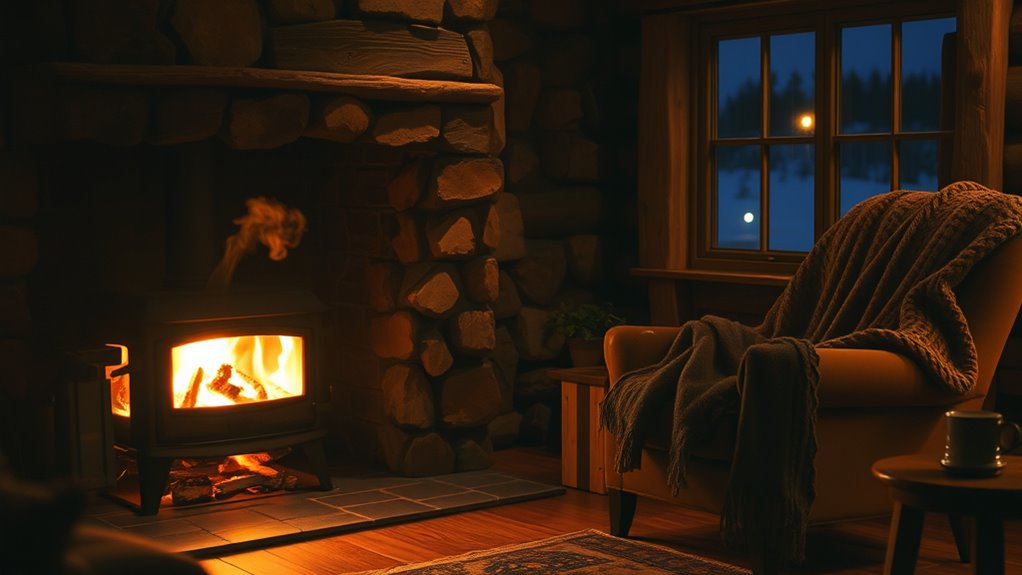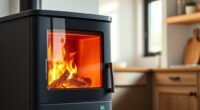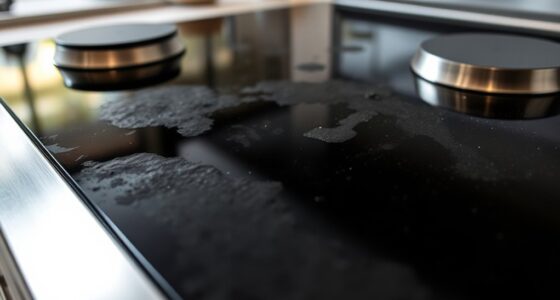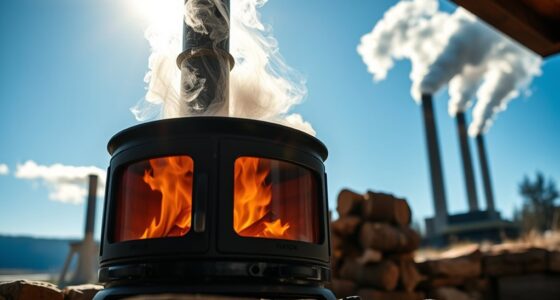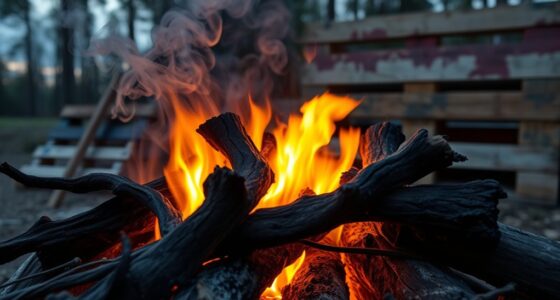Leaving a wood stove burning overnight isn’t generally safe unless you follow strict safety measures like using well-seasoned firewood, installing smoke and carbon monoxide detectors, and ensuring proper ventilation. It’s best to reduce the fire to a low level or fully extinguish it before sleeping. If you want to learn more about staying safe during overnight heating and alternative options, there’s important information you should consider.
Key Takeaways
- Leaving a wood stove unattended increases the risk of house fires due to sparks or creosote buildup.
- Properly extinguish or reduce the fire to a safe, low level before leaving the stove unattended.
- Always use safety devices like smoke and carbon monoxide detectors when operating a stove overnight.
- Regular maintenance and inspection help prevent creosote accumulation and chimney fires.
- Consider alternative heating options for overnight use to ensure safety and continuous warmth.
Understanding How Wood Stoves Work
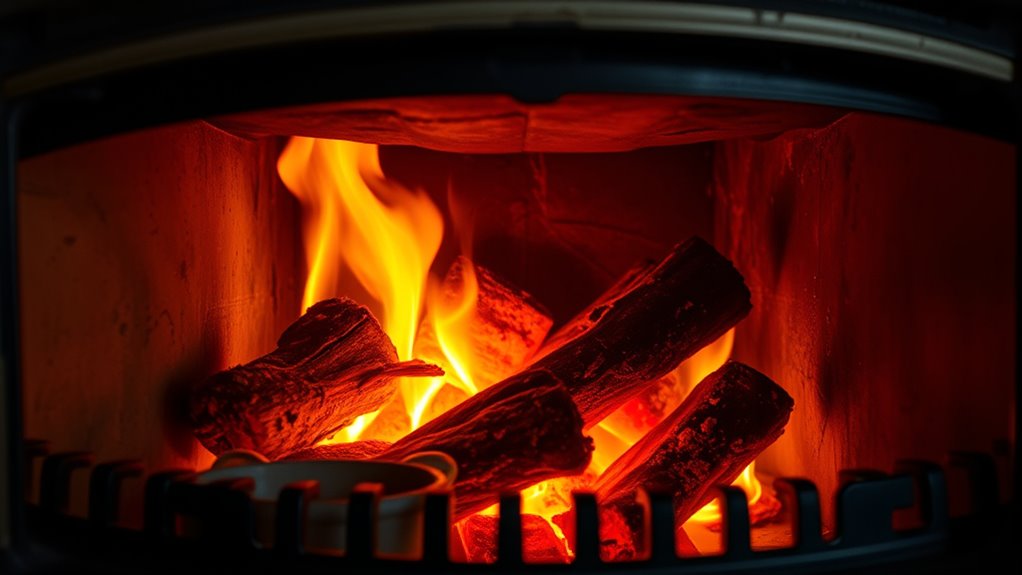
Wood stoves operate by burning logs to produce heat, with the combustion process fueled by airflow that supplies oxygen. This airflow creates a chimney draft, which pulls air into the stove and exhausts smoke outside. Proper draft ensures efficient burning and helps regulate temperature. Moisture control is also essential; seasoned logs with low moisture burn cleaner and produce less creosote buildup, reducing fire risk. When you understand how airflow and draft work, you’ll see how ventilation influences stove performance. Good draft maintains steady heat and prevents dangerous smoke backflow into your home. Keeping the chimney clear and ensuring proper moisture levels in your wood are key to safe, effective operation. Additionally, understanding ventilation principles can help optimize your stove’s efficiency and safety. Managing air supply and draft regulation can further improve burn quality and safety. By managing these factors, you help your wood stove burn safely and efficiently overnight, and using tuning techniques such as proper combustion settings can enhance overall safety and performance. Properly adjusting air intake can also improve combustion efficiency and reduce emissions. Regular maintenance and understanding how airflow affects combustion can further prevent issues like smoke spillage or incomplete burning.
Risks Associated With Leaving a Stove Unattended

Leaving a stove unattended overnight introduces significant safety risks that shouldn’t be overlooked. Unsupervised fires can easily cause house fires or carbon monoxide buildup. Over time, creosote buildup from incomplete combustion increases the risk of chimney fires, especially if you haven’t scheduled regular chimney cleaning. If you’re not in fireproof clothing, an accidental spark could ignite nearby materials. Additionally, home safety protocols recommend never leaving a fire unattended to prevent preventable accidents. Ensuring proper fire safety measures can significantly reduce these dangers and protect your home and loved ones. Regular maintenance and awareness of fire hazards are essential to ensure safe use of your stove. Furthermore, understanding the effects of creosote buildup can help prevent dangerous chimney fires and maintain a safe home environment. Being aware of proper ventilation techniques also plays a crucial role in maintaining safe combustion and air quality inside your home.
Safety Precautions Before Bedtime
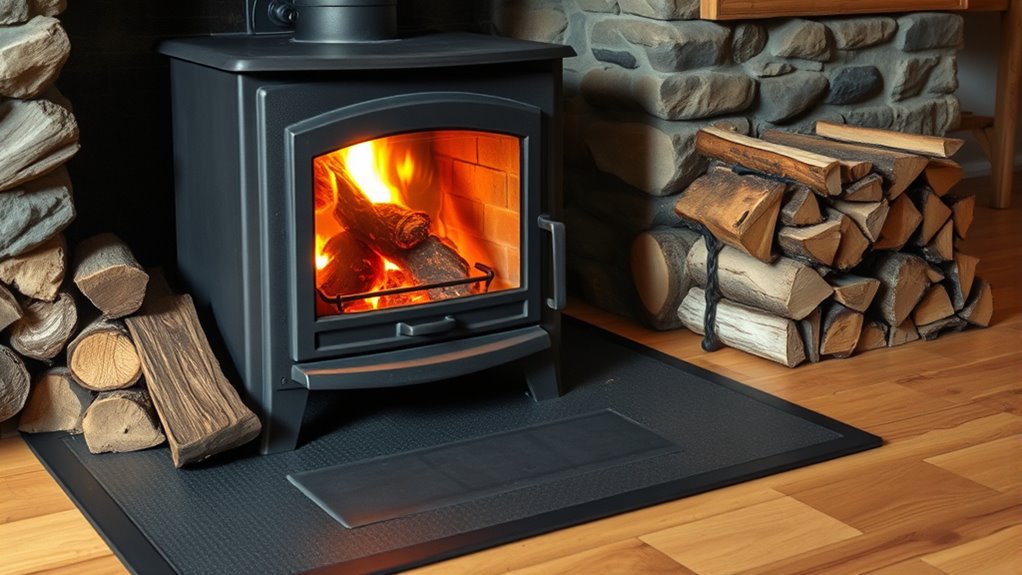
To guarantee safety before bed, you should take specific precautions when your stove is still burning. First, ensure your stove design includes features like a sturdy door and proper venting to contain embers and control airflow. Always double-check that the fire is fully extinguished or reduced to a safe, low level before leaving it unattended overnight. Practice good fire safety by keeping combustible materials away from the stove and installing a fire-resistant hearth pad. Use a stove thermometer to monitor temperature and prevent overheating. Additionally, consider installing smoke and carbon monoxide detectors in your home to alert you to any issues. Proper stove maintenance and adherence to safety guidelines are essential for minimizing risks, assuring your home remains safe while your stove is still warm. Regularly inspecting your stove and chimney cleaning can further prevent dangerous creosote buildup that could lead to fires. Ensuring proper ventilation can also help prevent dangerous fume buildup inside your home. Being aware of environmental benefits also encourages responsible usage and safety practices.
Proper Maintenance and Inspection
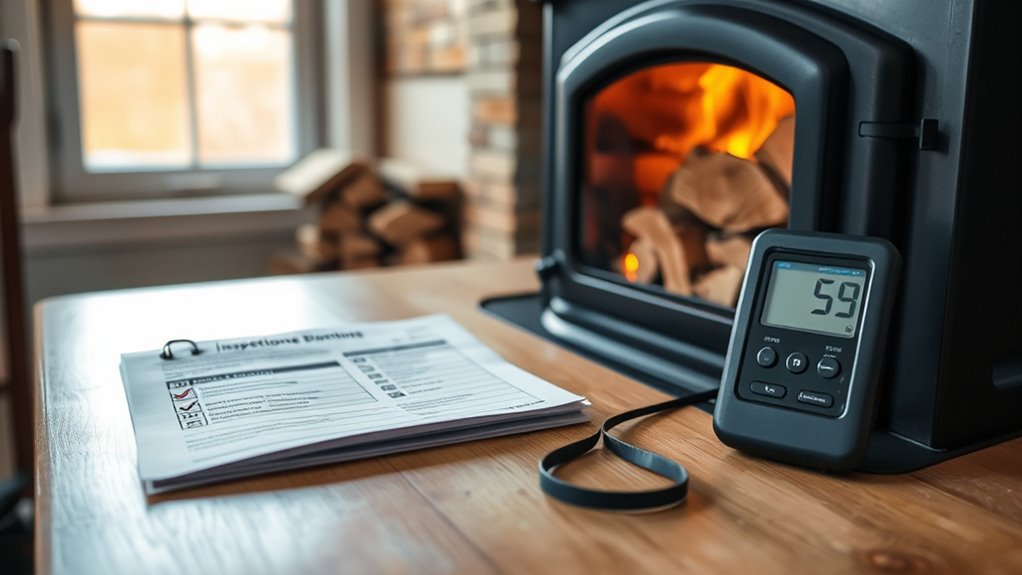
Regular maintenance and thorough inspections are vital for ensuring your stove operates safely and efficiently over time. Regularly check for creosote buildup and schedule chimney cleaning to prevent fire hazards. Always remove ash buildup to maintain proper airflow and combustion, which also improves heat output. Inspect the firebricks and door seals for cracks or damage, replacing them as needed. Keep the stovepipe clear of obstructions and check for any signs of wear or corrosion. Proper maintenance reduces the risk of dangerous smoke leaks and chimney fires. To stay safe, make a routine of cleaning the chimney, removing ash, and inspecting all components. Incorporating appliance maintenance plans into your routine can help identify underlying problems that might compromise safety. Additionally, staying aware of support hours for professional help can be crucial if issues arise unexpectedly. Being familiar with proper ventilation techniques ensures that harmful fumes are effectively expelled, further enhancing safety. Regularly reviewing safety guidelines for wood stove operation can also help prevent accidents. These simple steps help keep your wood stove functioning reliably and safely for overnight burns or long-term use.
Using the Right Fuel and Firewood
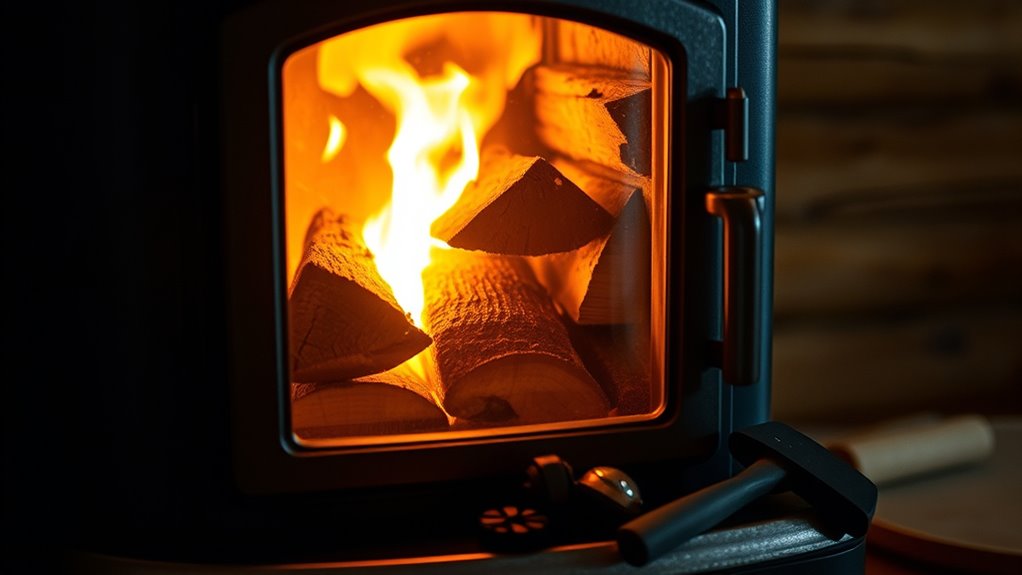
Choosing the right fuel and firewood is essential for safe and efficient burning overnight. Select well-seasoned firewood with low moisture content—ideally, aged for at least six months—to guarantee maximum stove efficiency. Hardwoods like oak, maple, or hickory burn longer, produce more heat, and create less creosote buildup. Avoid softwoods such as pine or cedar, which burn quickly and produce more creosote, increasing the risk of chimney fires. Proper firewood selection ensures a steady, controlled burn, reducing the chances of overheating or dangerous flare-ups. Additionally, consistent, high-quality firewood helps maintain your stove’s performance and safety, especially during overnight burns. Always store your firewood properly to keep it dry and free of mold or pests. Understanding fireplace safety and proper maintenance can further prevent hazards associated with overnight burns. Using fire safety tips can help ensure your fire remains controlled and safe throughout the night. Regularly inspecting your stove and chimney for creosote buildup is also crucial in preventing potential fire hazards. Being aware of the types of firewood and their burning characteristics can lead to safer and more effective use of your stove.
Installing Safety Devices and Alarms
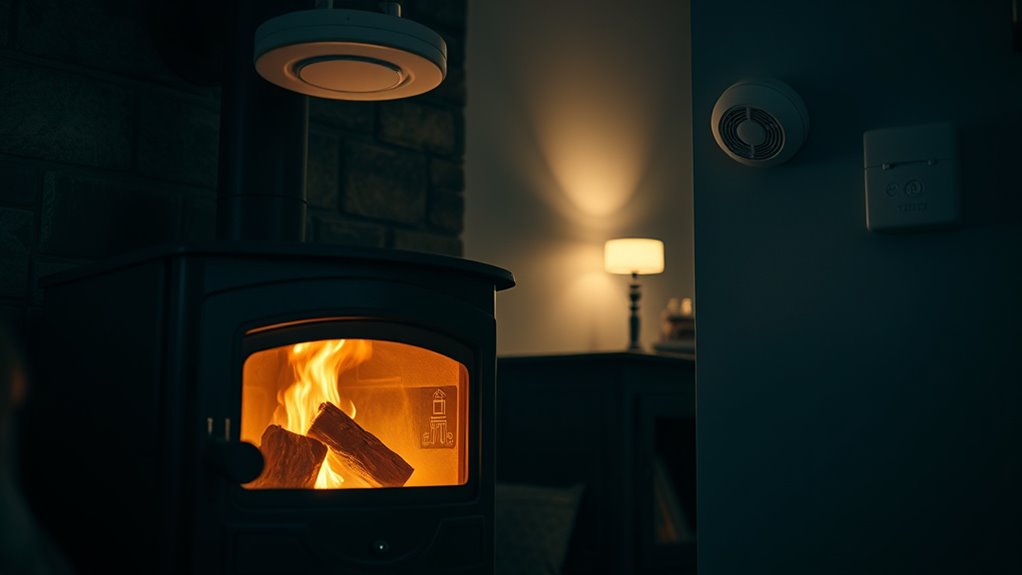
Installing safety devices and alarms is a crucial step in guaranteeing your wood stove remains safe during overnight use. You should invest in reliable carbon monoxide monitors to detect dangerous gases early. Additionally, place fire resistant mats under and around your stove to prevent accidental fires from sparks or embers. Consider installing smoke detectors in the same room for added protection. Regularly test all alarms to ensure they’re functioning correctly. You might also add heat sensors that alert you if the stove overheats. Keep a fire extinguisher nearby for emergencies. These measures help you stay alert to potential hazards, giving you peace of mind when leaving the stove burning overnight. Proper installation and maintenance of safety devices can make all the difference in preventing accidents.
Alternatives to Overnight Burning
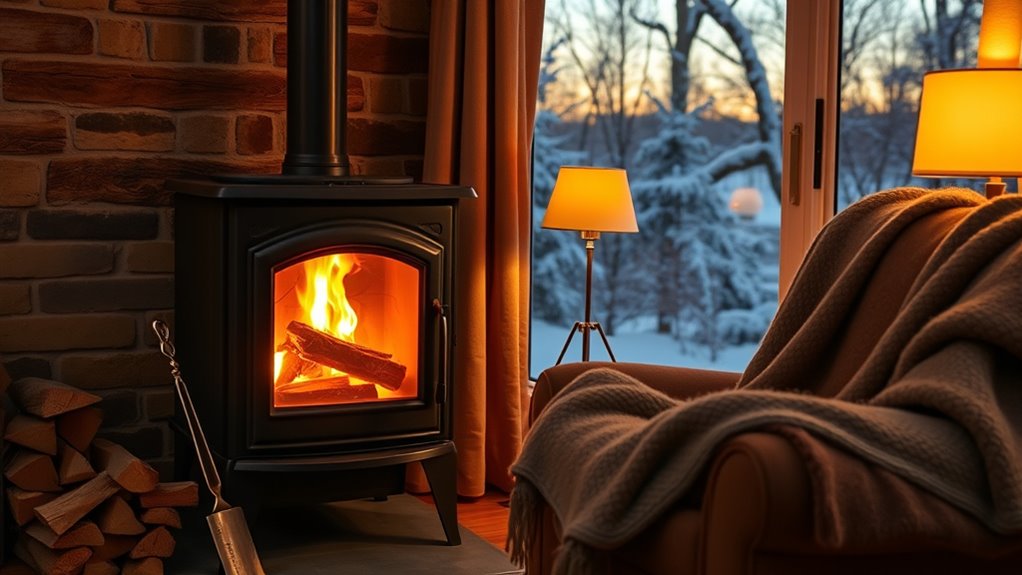
Instead of leaving your wood stove burning overnight, consider safer options like overnight heating devices designed for continuous use. These appliances are built to manage heat safely and reduce fire risks. Switching to these alternatives can keep your home warm without the dangers of overnight burning. Additionally, modern heating solutions often include energy-efficient designs that help minimize energy consumption while providing reliable warmth. Incorporating fire safety measures can further enhance security when using alternative heating methods.
Safe Fire Management
To manage fire safety overnight, it’s important to contemplate alternatives to leaving a wood stove burning unattended. Proper fire management involves several key steps. First, ensure your chimney is regularly cleaned to prevent creosote buildup, reducing the risk of chimney fires. Use fireproof mats beneath the stove to contain any stray sparks or hot embers. Always keep a fire extinguisher nearby and install smoke and carbon monoxide detectors. Additionally, consider staging your fire: gradually reduce the burn before bed to allow the fire to die down safely. Never leave a stove unattended with a dangerously high fire. Regular maintenance of your stove and chimney can significantly reduce safety risks. Taking these precautions ensures your home remains safe while maintaining effective fire management without overnight burning.
Overnight Heating Devices
If you want to keep your home warm overnight without the risks of leaving a wood stove burning, several reliable alternatives are available. Electric heaters and heated blankets provide safe, controlled warmth. Using fireproof mats under space heaters prevents accidental fires, especially if you forget to turn them off. Regular chimney cleaning ensures proper airflow, reducing fire hazards when using alternative devices. These options let you maintain comfort without the dangers associated with overnight stove operation.
| Alternative Device | Key Benefit |
|---|---|
| Electric space heaters | Quick, adjustable heat; safety features |
| Heated blankets | Personal warmth; energy-efficient |
| Oil-filled radiators | Consistent, long-lasting heat |
| Infrared panels | Safe, even heat distribution |
| Electric fireplaces | Cozy ambiance with minimal risk |
Emergency Preparedness and Response
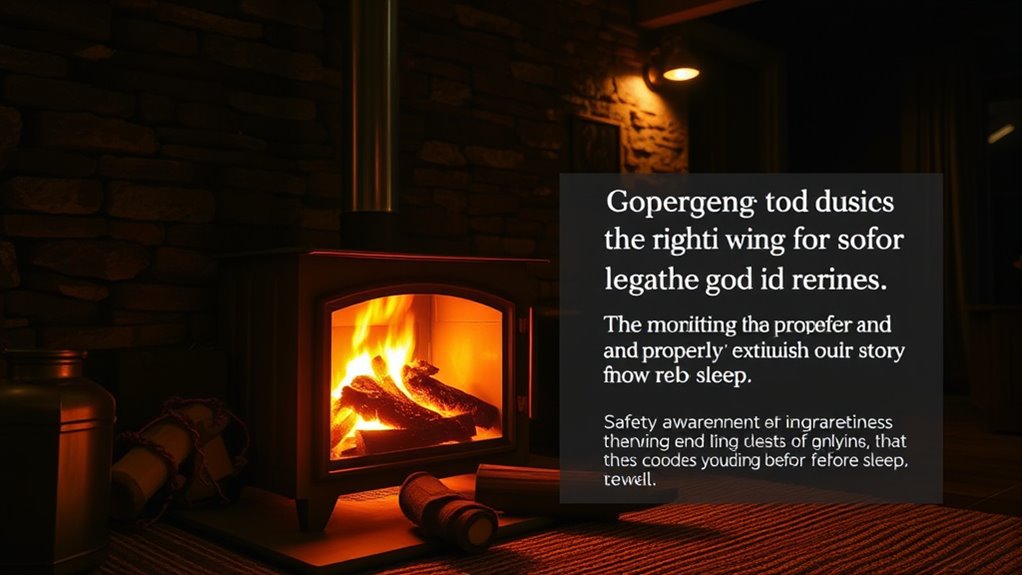
Are you prepared to handle emergencies related to your wood stove? Staying ready can prevent disasters. Keep a fire extinguisher nearby and guarantee it’s in working order. Regular chimney cleaning reduces the risk of chimney fires. Create an emergency plan that includes escape routes and safe zones. Keep smoke and carbon monoxide detectors functioning and test them monthly. Have a first aid kit accessible for burns or other injuries. Knowing how to respond quickly can save lives. Remember, even if you’re cautious, accidents happen—so preparedness is key. By staying vigilant and maintaining safety equipment, you can better protect yourself and your loved ones during unexpected incidents. Preparation makes all the difference in managing emergencies effectively.
Making an Informed Decision About Overnight Use
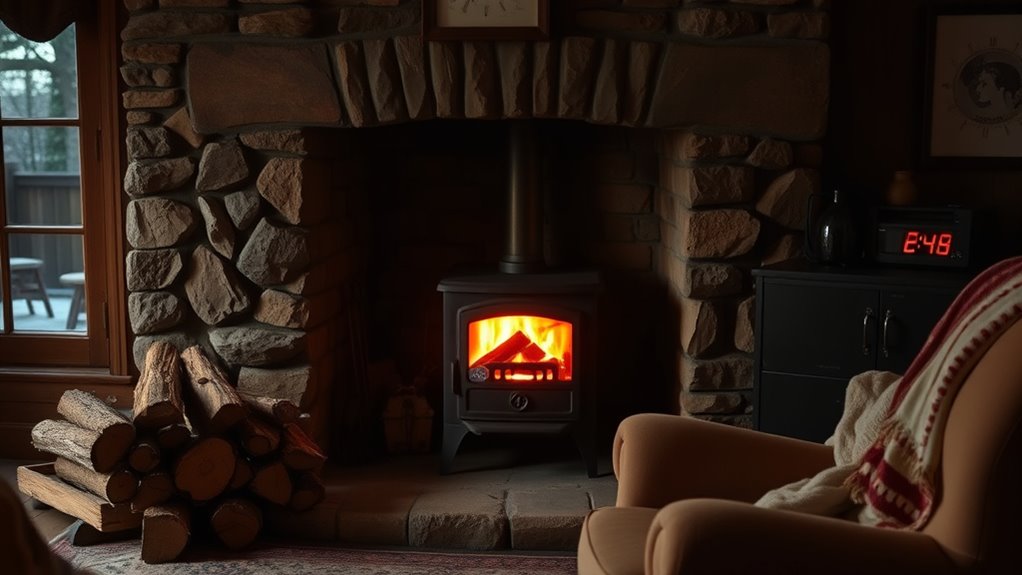
Deciding whether to leave a wood stove burning overnight requires careful consideration of safety, practicality, and your home’s specific setup. Before making this decision, ensure your chimney is properly cleaned and inspected regularly to prevent creosote buildup, which can cause dangerous chimney fires. Keep a fire extinguisher nearby, rated for fires involving wood and electrical equipment, and know how to use it. Consider your home’s ventilation, smoke alarms, and whether you can monitor the stove remotely or have someone check in overnight. If you choose to leave it burning, follow all safety precautions, such as using seasoned firewood and avoiding overloading the stove. Making an informed decision helps protect your home and loved ones, reducing the risk of accidents.
Frequently Asked Questions
Can Leaving a Wood Stove on Overnight Cause House Fires?
Leaving a wood stove on overnight can pose risks, including house fires if not properly maintained. If you neglect chimney maintenance, creosote buildup could ignite, causing a fire. Additionally, leaving it unattended increases the risk of carbon monoxide buildup, which can be deadly. Always verify your chimney is clean, and install carbon monoxide detectors. It’s safest to extinguish the fire before bed and only leave a stove burning if it’s designed for continuous use.
What Are the Signs of a Wood Stove Malfunction?
You should watch for signs of a wood stove malfunction, like smoke backing up into your home or difficulty maintaining a proper burn. Check for chimney blockages or draft issues, which can cause dangerous smoke buildup or inefficient heating. Unusual smells, excessive ash, or a lingering soot odor also indicate a problem. Regularly inspect your stove and chimney to guarantee safe operation and prevent potential hazards.
How Does Insulation Affect Overnight Stove Safety?
Insulation plays a key role in overnight stove safety by enhancing insulation effectiveness and thermal retention. When your home’s insulation is good, it helps maintain a steady temperature, reducing the risk of rapid cooling or overheating. Proper insulation around your stove and chimney keeps heat contained, minimizing fire hazards and ensuring safe operation. However, always monitor your stove and never rely solely on insulation for safe overnight burning.
Are There Specific Stove Models Safer for Overnight Use?
Imagine waking up to a warm, cozy home, but is your stove model truly safe for overnight use? Some models come with advanced safety features like automatic shut-off or oxygen depletion sensors, making them more reliable. You should always check your stove’s safety features and manufacturer recommendations. Choosing a reputable stove model with built-in safety mechanisms reduces risks, but never forget to exercise caution and follow safety guidelines for overnight burning.
What Insurance Implications Exist for Overnight Stove Burning?
Leaving your wood stove burning overnight can impact your insurance claims and policy coverage. If a fire occurs while you’re away, insurers may deny coverage if they find negligence or improper use. Check your policy details to understand coverage limits and exclusions related to unattended fires. Always guarantee safety measures are in place, and notify your insurer if you plan to leave the stove unattended to avoid potential claim issues.
Conclusion
So, you’re considering leaving your wood stove burning overnight? Maybe you think it’s a cozy way to save energy or just too much effort to turn off. Just remember, a little fire safety goes a long way—unless you’re aiming for an unexpected indoor bonfire. Play it safe, stay alert, and don’t let your sleep be the spark of a disaster. After all, who needs fire drills when you’ve got a warm, yet potentially combustible, home?

